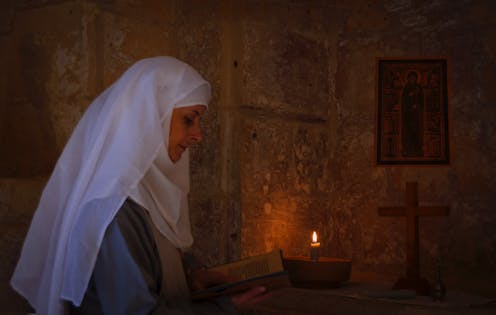The struggle to find silence in the ancient monastic world – and now
Monasticism developed in part because people were seeking the solace of quiet places But finding solitude was a struggle. And many realized that true silence could be found only within.

In our contemporary world, noise pollution has reached dangerous levels.
The World Health Organization has argued that “excessive noise” is a serious threat to human health. Studies have shown that excessive exposure to noise not only causes hearing loss but also leads to heart disease, poor sleep and hypertension.
In some parts of the world, a mysterious “droning sound,” similar to a “a diesel engine idling nearby,” has been described as “torture” for the small percent of the population that can hear it.
I’m a scholar of early Christianity and my research shows that monasticism developed in part because people were seeking the solace of quiet places.
But for them, like us, it was a struggle.
Ancient philosophers on noise

Ancient Greek and Roman philosophers frequently regarded noise as a serious distraction, one that challenged their ability to concentrate.
To give just one example: The Stoic philosopher Seneca described in great detail the noises coming from a bathhouse just below the room where he was writing, expressing his irritation at the distracting “babel” all around him. At the end of his letter, he says he has decided to withdraw to the country for quiet.
Noise and Christian monasticism
There were many reasons why Christian monasticism developed.
Ancient Christian writers, like John Cassian, claimed that the origins of monasticism lay in the examples set by the apostles of Jesus, who gave up everything to follow him.
Some modern scholars have argued that monasticism was a natural development following the early history of persecution of Christians, which shaped a view of suffering as a key way to show one’s dedication to the faith.
While the origins of monasticism are not entirely clear, scholars do know that Christian monks drew upon philosophical views about noise and distraction and, in some cases, chose to leave the cacophony of urban life for the wilderness. Even when they stayed in cities or villages, writings from this time period show that they were seeking a life free from the distractions and burdens of society.
Take, for example, the story of Paul, a young Christian in third-century Egypt, identified by his biographer, Jerome, as “the first hermit.”
Jerome says that Paul “amid thunders of persecution retired to a house at a considerable distance and in a more secluded spot.”
The story of Antony, a contemporary of Paul’s, is written by the Alexandrian bishop Athanasius, who describes how Antony was left burdened by caring for his sister after the death of his parents. Distracted by the crowds of neighbors demanding access to his parents’ wealth and property he chose to leave his village and embark on a life as a hermit.
Noise in the desert
Noise came in many forms. In “The Life of Antony,” for example, demons thunder, crash and hiss. Although the descriptions of such sounds might seem to be auditory hallucinations, the texts do regard them as real, not fictional.
Monastic rules and sayings instruct monks about the dangers of human speech, laughter, and even the noise of children in monasteries.
These texts emphasize the importance of silence in two forms: a quiet environment in which monks can concentrate and also refrain from too much speaking. Many of the sayings urge monks to “keep silent.”
Seeking silence
But even as these stories suggest that Christian monks were choosing solitude by going into the desert, the same stories show that silence was not to be found even in the remotest desert wilds.
As the reputation of Antony and other monks from Egypt spread around the Mediterranean, the stories of Antony complain that “the desert has become a city.”
Too many people, it seems, sought the wisdom of the hermits and created a distraction akin to city life by taking pilgrimages to see them.

The challenges of noise and distraction were, in fact, always part of the monastic life.
And so it remains to this day. One of the ways that monks and nuns have dealt with this challenge is by cultivating a sense of inner silence and inner stillness through practices like meditation, prayer and sitting in solitude.
In Greek, the language of the earliest Christian monastic texts, the word “hesychia” is used to describe the “interior stillness … that brings forth all the virtues” and over time it comes to be a central goal of Christian monasticism.
The ancient quest for silence can perhaps teach us how to respond to the challenges of our increasingly loud world and find our own silence.
[ Like what you’ve read? Want more? Sign up for The Conversation’s daily newsletter. ]
Kim Haines-Eitzen does not work for, consult, own shares in or receive funding from any company or organization that would benefit from this article, and has disclosed no relevant affiliations beyond their academic appointment.
Read These Next
What’s at stake in Trump’s executive order aiming to curb state-level AI regulation
In the absence of comprehensive federal AI regulation, states have stepped in. The Trump administration,…
The Bible says little about Jesus’ childhood – but that didn’t stop medieval Christians from enjoyin
Legends about Jesus’ early years that circulated in medieval Europe often drew on apocryphal texts.
Data centers need electricity fast, but utilities need years to build power plants – who should pay?
How many data centers will be built – and how much electricity they’ll need – is uncertain. Being…





